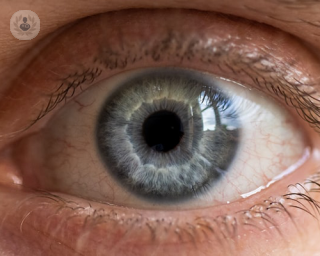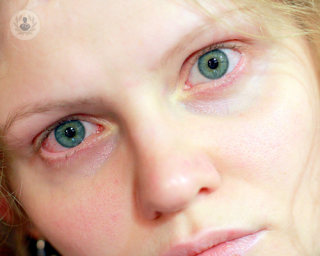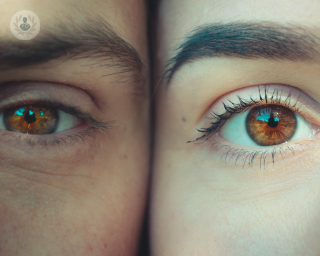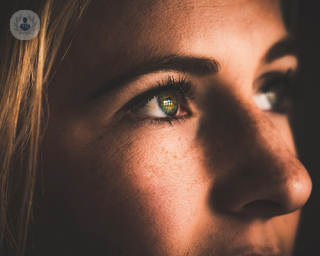What is uveitis?
Uveitis describes inflammation of the uvea, the middle part of the eye made up of the choroid, ciliary body, and the iris. Uveitis can be either infectious or non-infectious. It is important to exclude infection before starting treatment.

What are the different types of uveitis?
There are different types of uveitis depending on the part of the uvea affected:
- Anterior uveitis (iritis): is the most common type of uveitis and occurs in the front of the eye. Anterior uveitis is typically painful and provokes sensitivity to light. Sometimes, anterior uveitis can be asymptomatic and only picked up after it has been present for some time.
- Intermediate uveitis: this refers to when the bulk of the inflammation lies behind the lens and in front of the retina. It can develop at any age and occasionally does not require any treatment other than close observation.
- Posterior uveitis (choroiditis): affects the back of the eye, mainly around the retina and choroid. It may be related to an infection or an autoimmune process. It is typically sight threatening and treatment is advised.Panuveitis: is when all compartments of the eye are affected.
- Panuveitis: is when all compartments of the eye are affected.·
What are the symptoms of uveitis?
There are several possible symptoms related to uveitis, such as:
- Eye pain- this is normally an ache which either remains in or around your eye. The pain may augument when you need to focus on something.
- Eye redness.
- Sensitivity to light.
- Blurry vision
- Floaters (small dots, squiggly lines) and flashing lights across vision.
Symptoms often develop rapidly but may also develop over several days.
What causes uveitis?
Uveitis may be caused by infection and autoimmune conditions, but may also be triggered by surgery or trauma. The following infections are typically screened for: HIV, syphilis, tuberculosis, herpes, and toxoplasmosis. These infections are rare, but treatable and early identification is extremely important. More commonly, uveitis is caused by a dysregulation in your immune system, whereby your immune cells recognise your eye as 'abnormal' and attack it.
Are certain age groups more likely to develop uveitis?
Uveitis can affect people of any age.
Can uveitis be caused by stress?
Yes, stress can increase your likelihood of developing uveitis.
How can it be prevented?
Unfortunately, uveitis cannot really be prevented. However, it is common for patients to have associated stress, illness, and tiredness with a flare up of their symptoms.
How can it be treated?
Treatment depends on the area of the eye affected. For anterior uveitis, most patients are managed with steroid eye drops. This may be either during a flare up of uveitis, or as maintenance therapy.
Patients with intermediate, posterior and panuveitis are more likely to require either systemic treatment or medication injected into the eye. After your eyes have been reviewed, the pros and cons of topical vs systemic treatment will be explained and discussed. It is difficult to generalise, but a treatment will usually be recommended that is most likely to be effective with the fewest side effects.
As a general principle, eye inflammation is managed as proactively as possible with steroid drops, injections, or tablets. A period of inactivity is then maintained with medications that are safer and easier to take than steroids. Occasionally surgery is carried out if related complications arise, such as glaucoma or cataracts.

When should I seek medical advice?
We recommend that you seek medical advice immediately if you notice an unusal change in vision or eye pain which is continual. If you contact your GP about this pain, they may refer you to an ophthalmologist (an eye specialist.)
11-13-2012 09-26-2023Uveitis
Ms Theresa Richardson - Ophthalmology
Created on: 11-13-2012
Updated on: 09-26-2023
Edited by: Aoife Maguire
What is uveitis?
Uveitis describes inflammation of the uvea, the middle part of the eye made up of the choroid, ciliary body, and the iris. Uveitis can be either infectious or non-infectious. It is important to exclude infection before starting treatment.

What are the different types of uveitis?
There are different types of uveitis depending on the part of the uvea affected:
- Anterior uveitis (iritis): is the most common type of uveitis and occurs in the front of the eye. Anterior uveitis is typically painful and provokes sensitivity to light. Sometimes, anterior uveitis can be asymptomatic and only picked up after it has been present for some time.
- Intermediate uveitis: this refers to when the bulk of the inflammation lies behind the lens and in front of the retina. It can develop at any age and occasionally does not require any treatment other than close observation.
- Posterior uveitis (choroiditis): affects the back of the eye, mainly around the retina and choroid. It may be related to an infection or an autoimmune process. It is typically sight threatening and treatment is advised.Panuveitis: is when all compartments of the eye are affected.
- Panuveitis: is when all compartments of the eye are affected.·
What are the symptoms of uveitis?
There are several possible symptoms related to uveitis, such as:
- Eye pain- this is normally an ache which either remains in or around your eye. The pain may augument when you need to focus on something.
- Eye redness.
- Sensitivity to light.
- Blurry vision
- Floaters (small dots, squiggly lines) and flashing lights across vision.
Symptoms often develop rapidly but may also develop over several days.
What causes uveitis?
Uveitis may be caused by infection and autoimmune conditions, but may also be triggered by surgery or trauma. The following infections are typically screened for: HIV, syphilis, tuberculosis, herpes, and toxoplasmosis. These infections are rare, but treatable and early identification is extremely important. More commonly, uveitis is caused by a dysregulation in your immune system, whereby your immune cells recognise your eye as 'abnormal' and attack it.
Are certain age groups more likely to develop uveitis?
Uveitis can affect people of any age.
Can uveitis be caused by stress?
Yes, stress can increase your likelihood of developing uveitis.
How can it be prevented?
Unfortunately, uveitis cannot really be prevented. However, it is common for patients to have associated stress, illness, and tiredness with a flare up of their symptoms.
How can it be treated?
Treatment depends on the area of the eye affected. For anterior uveitis, most patients are managed with steroid eye drops. This may be either during a flare up of uveitis, or as maintenance therapy.
Patients with intermediate, posterior and panuveitis are more likely to require either systemic treatment or medication injected into the eye. After your eyes have been reviewed, the pros and cons of topical vs systemic treatment will be explained and discussed. It is difficult to generalise, but a treatment will usually be recommended that is most likely to be effective with the fewest side effects.
As a general principle, eye inflammation is managed as proactively as possible with steroid drops, injections, or tablets. A period of inactivity is then maintained with medications that are safer and easier to take than steroids. Occasionally surgery is carried out if related complications arise, such as glaucoma or cataracts.

When should I seek medical advice?
We recommend that you seek medical advice immediately if you notice an unusal change in vision or eye pain which is continual. If you contact your GP about this pain, they may refer you to an ophthalmologist (an eye specialist.)


Ask an expert: How is anterior uveitis treated?
By Mr Harry Petrushkin
2024-12-26
An inflammation of the iris, known as iritis or anterior uveitis, can cause sharp pain in the eye and an increased sensitivity to light. To avoid more serious complications, prompt treatment is required. To give expert insight on this condition, we invitied renowned consultant ophthalmic surgeon Mr Harry Petrushkin to outline the symptoms and treatment of anterior uveitis. See more


How to spot uveitis
By Ms Theresa Richardson
2024-12-26
Many things can irritate your eyes, and all of us will experience the symptoms of pink-eye in our lifetimes. While conjunctivitis or infections are more common causes, a more unusual possibility is that of uveitis. What exactly is this condition? Top ophthalmologist Ms Theresa Richardson explains all. See more


All you need to know about uveitis
By Dr Srilakshmi Sharma
2024-12-26
Uveitis is a form of eye inflammation that can lead to irreversible vision loss if left untreated. In her latest article, Dr Srilakshmi Sharma, one of our top consultant ophthalmologists, talks about the causes of this eye condition, the signs and symptoms, the risks it poses and what treatments are available to help control its progression. See more


Uveitis cataracts: how common are they?
By Ms Theresa Richardson
2024-12-23
In patients with chronic eye inflammation (uveitis), cataracts are a common complication because of prolonged use of high-dose steroids used to treat the primary condition. Leading ophthalmologist Ms Theresa Richardson explains why it is still important for patients to use the steroids as it would be more detrimental without. See more
Experts in Uveitis
-
Ms Theresa Richardson
OphthalmologyExpert in:
- Cataracts
- Macular degeneration (AMD)
- Diabetic retinopathy
- Uveitis
- Glaucoma
- Stye
-
Miss Shahrnaz Izadi
OphthalmologyExpert in:
- Retinopathy
- Cataracts
- Uveitis
- Diabetic retinopathy
- Macular degeneration (AMD)
- Dry eye
-
Mr Harry Petrushkin
OphthalmologyExpert in:
- Cataract surgery
- Scleritis
- Uveitis
- Retina
- Paediatric ophthalmology
- Cataracts
-
Mr Ahmed Saad
OphthalmologyExpert in:
- Cataract surgery
- Lens replacement (intraocular lenses)
- Vitrectomy
- Retinal detachment surgery
- Macular hole
- Uveitis
-
Mr Eduardo Normando
OphthalmologyExpert in:
- Glaucoma
- Emergency eye care
- Dry eye
- Blepharitis
- Corneal abrasion
- Uveitis
- See all

Shirley Oaks Hospital - part of Circle Health Group
Shirley Oaks Hospital - part of Circle Health Group
Poppy Lane, Croydon CR9 8AB
No existe teléfono en el centro.
By using the telephone number provided by TOP DOCTORS, you automatically agree to let us use your phone number for statistical and commercial purposes. For further information, read our Privacy Policy
Top Doctors

The Chiltern Hospital - part of Circle Health Group
The Chiltern Hospital - part of Circle Health Group
London Rd, Great Missenden HP16 0EN
No existe teléfono en el centro.
By using the telephone number provided by TOP DOCTORS, you automatically agree to let us use your phone number for statistical and commercial purposes. For further information, read our Privacy Policy
Top Doctors

Darwin Eye Consultants
Darwin Eye Consultants
Nuffield Health Shrewsbury Hospital, Longden Road
No existe teléfono en el centro.
By using the telephone number provided by TOP DOCTORS, you automatically agree to let us use your phone number for statistical and commercial purposes. For further information, read our Privacy Policy
Top Doctors
-
Shirley Oaks Hospital - part of Circle Health Group
Poppy Lane, Croydon CR9 8AB, South LondonExpert in:
- General Surgery
- Orthopaedic surgery
- Plastic surgery, reconstructive and aesthetics
- Gastroenterology
- Obstetrics and Gynaecology
- Neurosurgery
-
The Chiltern Hospital - part of Circle Health Group
London Rd, Great Missenden HP16 0EN, Great MissendenExpert in:
- Allergies Ophthalmological
- Clinical analysis
- Cancer
- Breast Cancer
- Skin Cancer
- Prostate Cancer
-
Darwin Eye Consultants
Nuffield Health Shrewsbury Hospital, Longden Road, ShrewsburyExpert in:
- Blepharoplasty
- Cataracts
- Eyelid surgery
- Oculoplastics surgery
- Laser eye surgery
- Complex eye conditions
- See all
- Most viewed diseases, medical tests, and treatments
- Visual impairment
- Diabetic retinopathy
- Retina
- Presbyopia
- Nystagmus
- Myopia
- Hyperopia (farsightedness)
- Eye examination
- Blepharitis
- Astigmatism







